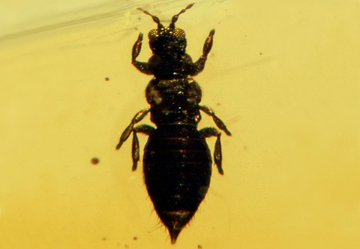Abstract
Through the ongoing research on Burmese amber, our knowledge about mid-Cretaceous life on an island in the Tethys ocean continuingly increases (Ross, 2019, 2020; Westerwheel et al., 2019), a life that was exotic and highly endemic (Zhang, 2018; Rasnitsyn & Öhm-Kühnle, 2018a). Among its rich biota is the extinct, strictly Cretaceous family Serphitidae of the Hymenoptera, which still is underexplored. Serphitidae are known in Burmese amber in two subfamilies, one of them (Supraserphitinae) is confined exclusively to Burmese amber and recorded just with one genus and, before the present study, two species (Rasnitsyn & Öhm-Kühnle, 2018b, c). Another subfamily, Serphitinae, is known from three genera, with the type genus Serphites Brues, 1937 (Engel, 2015), which is the most diverse serphitid genus in other Cretaceous ambers and most likely in Burmese amber as well. While the description of Burmese Serphitinae needs to be reserved for our future research, the present work is devoted to the recently described genus Supraserphites Rasnitsyn & Öhm-Kühnle, 2018, the only one in the subfamily Supraserphitinae. We are adding two new species to this genus, hereby doubling its numbers.
References
Cruickshank, R.D. & Ko, K. (2003) Geology of an amber locality in the Hukawng Valley, northern Myanmar. Journal of Asian Earth Sciences, 21, 441–455.
https://doi.org/10.1016/S1367-9120(02)00044-5
Engel, M.S. (2015) A new family of primitive serphitoid wasps in Lebanese amber (Hymenoptera: Serphitoidea). Novitates Palaeoentomologicae, 13, 1–22.
https://doi.org/10.17161/np.v0i13.5064
Engel, M.S., Grimaldi, D.A. & Ortega-Blanco, J. (2011) Serphitid wasps in Cretaceous amber from New Jersey (Hymenoptera: Serphitidae). Insect Systematics and Evolution, 42 (2), 197–204.
https://doi.org/10.1163/187631211X560892
Engel, M.S. & Perrichot, V. (2014) The extinct wasp family Serphitidae in Late Cretaceous Vendean amber (Hymenoptera). Paleontological Contributions, 10J, 46–51.
https://doi.org/10.17161/PC.1808.15990
Li, L., Shih, C., Rasnitsyn, A.P., Li, D. & Ren, D. (2018) A new wasp of Myanmarinidae (Hymenoptera: Stephanoidea) from the mid-Cretaceous Myanmar amber. Cretaceous Research, 86, 33–40.
https://doi.org/10.1016/j.cretres.2018.02.009
McKellar, R.C. & Engel, M.S. (2011) The serphitid wasps (Hymenoptera: Proctotrupomorpha: Serphitoidea) of Canadian Cretaceous amber. Systematic Entomology, 36 (1), 192–208.
https://doi.org/10.1111/j.1365-3113.2010.00559.x
Ortega-Blanco, J., Delclòs, X., Peñalver, E. & Engel, M. S. (2011) Serphitid wasps in Early Cretaceous amber from Spain (Hymenoptera: Serphitidae). Cretaceous Research, 32 (2), 143–154.
https://doi.org/10.1016/j.cretres.2010.11.004
Rasnitsyn, A.P. & Öhm-Kühnle, Ch. (2018a) Three new female Aptenoperissus from mid-Cretaceous Burmese amber (Hymenoptera, Stephanoidea, Aptenoperissidae): Unexpected diversity of paradoxical wasps suggests insular features of source biome. Cretaceous Research, 91, 168–175.
https://doi.org/10.1016/j.cretres.2018.06.004
Rasnitsyn, A.P. & Öhm-Kühnle, Ch. (2018b) New serphitoid wasp Supraserphites draculi gen. sp. nov. in Burmese amber (Hymenoptera, Serphitidae: Supraserphitinae). Cretaceous Research, 99, 46–50.
https://doi.org/10.1016/j.cretres.2018.12.006
Rasnitsyn, A.P. & Öhm-Kühnle, Ch. (2018c) New species of serphitoid wasp genus Supraserphites Rasnitsyn & Öhm-Kühnle in Burmese amber (Hymenoptera, Serphitidae: Supraserphitinae). Palaeoentomology, 2 (1), 13–16.
https://doi.org/10.11646/palaeoentomology.2.1.3
Ross, A.J. (2019) Burmese (Myanmar) amber checklist and bibliography 2018. Palaeoentomology, 2 (1), 22–84.
https://doi.org/10.11646/palaeoentomology.2.1.5
Ross, A.J. (2020) Supplement to the Burmese (Myanmar) amber checklist and bibliography 2019. Palaeoentomology, 3 (1), 103–118.
https://doi.org/10.11646/palaeoentomology.3.1.14
Shi, G., Grimaldi, D.A., Harlow, G.E., Wang, J., Wang, J., Wang, M., Lei, W., Li, Q. & Li, X. (2012) Age constraint on Burmese amber based on U-Pb dating of zircons. Cretaceous Research, 37, 155–163.
https://doi.org/10.1016/j.cretres.2012.03.014
Westerweel, J., Roperch, P., Licht, A., Dupont-Nivet, G., Win, Z., Poblete, F., Ruffet, G., Swe. H.H., Thi, M.K. & Aung, D.W. (2019) Burma Terrane part of the Trans-Tethyan arc during collision with India according to palaeomagnetic data. Nature Geoscience, 12, 863–868.
https://doi.org/10.1038/s41561-019-0443-2
Zhang, Q., Rasnitsyn, A.P., Wang B. & Zhang, H.C. (2018) Hymenoptera (wasps, bees and ants) in mid-Cretaceous Burmese amber: a review of the fauna. Proceedings of the Geologists’ Association, 129 (6), 736–747.


